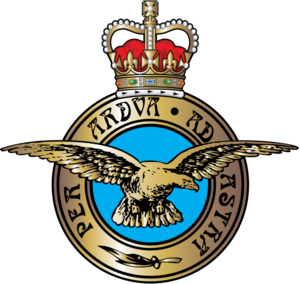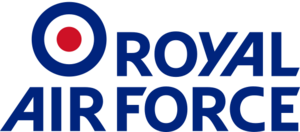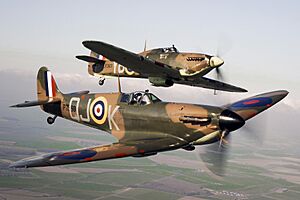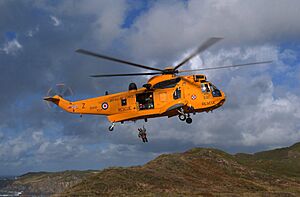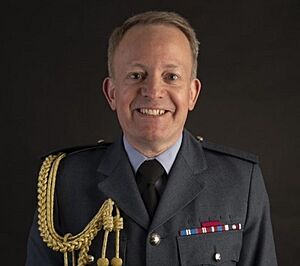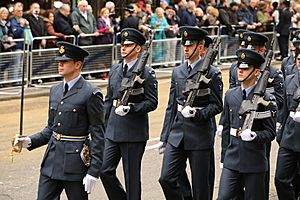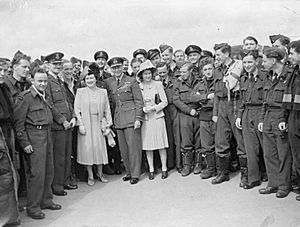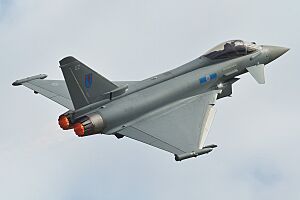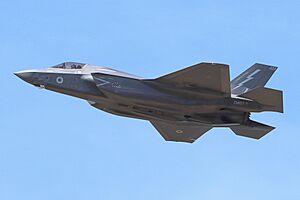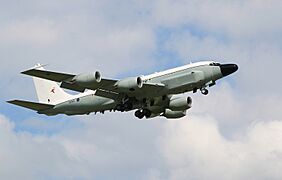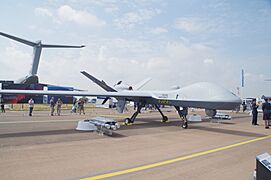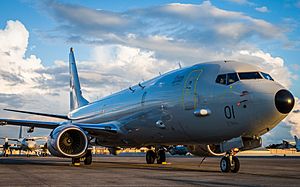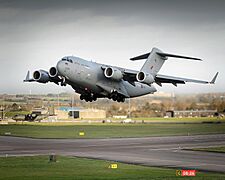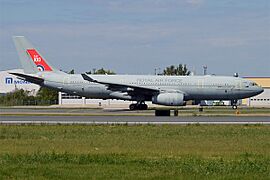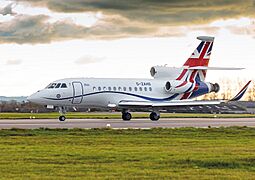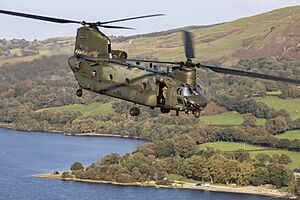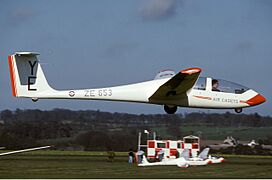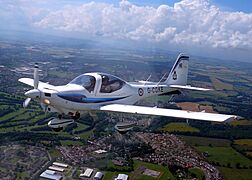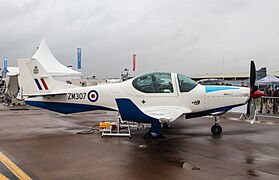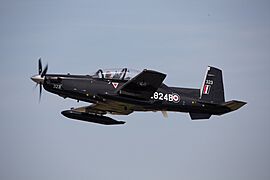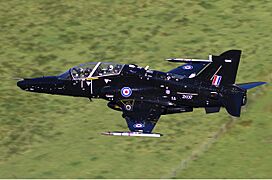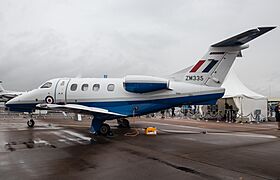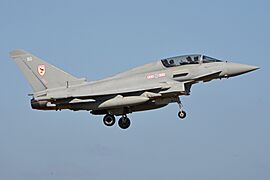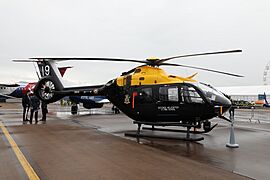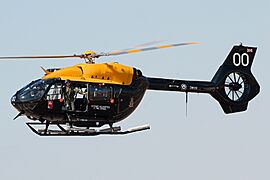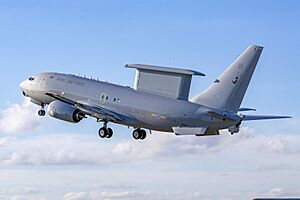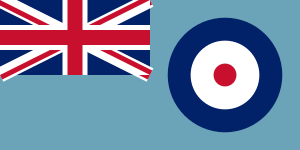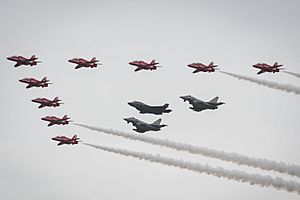Royal Air Force facts for kids
Quick facts for kids Royal Air Force |
|
|---|---|
| Founded | 1 April 1918 |
| Country | |
| Type | Air and space force |
| Role | Aerial and space warfare |
| Size |
|
| Part of | |
| Air Staff Offices | Whitehall, London |
| Motto(s) | "Per Ardua ad Astra" (Latin) (Through Adversity to the Stars) |
| Colours | Air force blue and gold |
| March | Quick: "Royal Air Force March Past" Slow: "Saeculum" |
| Anniversaries | 1 April |
| Engagements |
See list
|
| Commanders | |
| Head of the Armed Forces | |
| Secretary of State for Defence | |
| Chief of the Air Staff | |
| Deputy Chief of the Air Staff | |
| Air and Space Commander | |
| Warrant Officer of the Royal Air Force | |
| Insignia | |
| Roundel |   |
| Fin flash |   |
| Ensign |  |
| Aircraft flown | |
| Attack | MQ-9 Reaper Protector RG1 |
| Electronic warfare |
StormShroud |
| Fighter | Typhoon FGR4 F-35B Lightning |
| Helicopter | Chinook HC5/6/6A |
| Trainer helicopter | Juno HT1 Jupiter HT1 |
| Patrol | Poseidon MRA1 |
| Reconnaissance | Airseeker R1 Shadow R1/1A |
| Trainer | Hawk T1/2 Texan T1 Phenom T1 Typhoon T3 Viking T1 Prefect T1 Tutor T1 |
| Transport | Voyager KC2/3 Atlas C1 C-17 Globemaster Envoy IV CC1 |
| Tanker | Voyager KC2/3 |
The Royal Air Force (RAF) is the air and space force of the United Kingdom. It was created on April 1, 1918, near the end of the First World War. It was formed by combining the Royal Flying Corps (RFC) and the Royal Naval Air Service (RNAS). After the Allies won in 1918, the RAF became the largest air force in the world.
Since it was formed, the RAF has played a big part in British military history. During the Second World War, the RAF gained control of the skies over Britain. They did this during the Battle of Britain against Nazi Germany's Luftwaffe. The RAF also led the Allied effort to bomb enemy targets.
The RAF's main goal is to help the British Ministry of Defence (MOD). This means keeping the UK and its overseas territories safe, including from terrorism. They also support the government's goals for international peace. The RAF aims to be a "second to none" air force. They want to make a big difference using air power. Air power means using forces from the air and space to influence events.
Today, the Royal Air Force has many advanced aircraft. These include fighter jets, strike planes, and planes for intelligence, surveillance, and reconnaissance. They also have planes for signals intelligence (SIGINT) and air-to-air refueling. Most of the RAF's helicopters work with ground forces. Most RAF aircraft and personnel are based in the UK. Many others serve in operations around the world. These include places like Iraq and Syria, and overseas bases. The Royal Navy and British Army also have their own aircraft.
Contents
- History of the Royal Air Force
- How the RAF is Organized
- RAF Personnel
- RAF Ranks
- RAF Aircraft
- RAF Symbols and Uniforms
- Ceremonial Functions and Displays
- See also
History of the Royal Air Force
How the RAF Began
The Royal Air Force was created on April 1, 1918. It was the second independent air force in the world. It was formed by joining the Royal Flying Corps and the Royal Naval Air Service. This idea came from a report by Jan Smuts in 1917. On March 7, 1918, King George V officially named the new service the 'Royal Air Force'. When it started, the RAF was the biggest air force in the world.
After the First World War, the RAF became much smaller. It was in charge of British military actions in Iraq. It also carried out small tasks in other parts of the British Empire. This included setting up bases to protect Singapore. The RAF's naval aviation part, the Fleet Air Arm, started in 1924. It was given to the Admiralty in 1939. In 1925, the RAF had its first independent action. It successfully used air power against rebelling tribesmen in Pink's War.
The RAF decided to focus on strategic bombing. This meant building long-range bombers. This became their main bombing plan for the Second World War.
The Second World War
The Royal Air Force grew very quickly before and during the Second World War. Countries like Canada and Australia also trained air forces to work with the RAF. Many people from these countries and from occupied Europe joined RAF squadrons. By the end of the war, the Royal Canadian Air Force had over 30 squadrons with the RAF. About a quarter of Bomber Command's personnel were Canadian. The Royal Australian Air Force made up about nine percent of all RAF personnel in Europe.
In 1940, during the Battle of Britain, the RAF defended Britain's skies. They fought against the German Luftwaffe, which had more planes. This long air battle helped stop Operation Sea Lion. This was Hitler's plan to invade the UK. On August 20, Prime Minister Winston Churchill praised the RAF. He said, "Never in the field of human conflict was so much owed by so many to so few".

The RAF's biggest effort in the war was the strategic bombing campaign against Germany. At first, RAF bombing was not very effective. But later, especially under Air Chief Marshal Harris, the attacks became much stronger. This happened from early 1943 as new technology and more aircraft became available. The RAF bombed German cities at night, like Hamburg and Dresden. The RAF also developed special bombing methods for specific missions. One famous example was the "Dambusters" raid.
The Cold War Era
After the Second World War, the RAF changed a lot. New jet fighters and bombers arrived. One of the first big operations was the Berlin Airlift (Operation Plainfire). From June 1948 to May 1949, the RAF delivered 17% of all supplies to Berlin. They used planes like Avro Yorks and Douglas Dakotas. The RAF also had its first fights after the war. This happened during the 1948 Arab–Israeli War and against the Israeli Air Force.
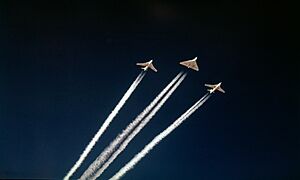
Britain developed its own nuclear weapons. The RAF's V bomber fleet was chosen to carry them. These planes first carried nuclear bombs. Later, they used the Blue Steel missile. In 1969, the Royal Navy's submarines took over the main nuclear role. The RAF's nuclear role then became smaller, using tactical bombs. This role continued until 1998.
During the Cold War, the RAF's main job was to defend Western Europe from the Soviet Union. Many RAF squadrons were based in West Germany. The RAF also fought in many other conflicts. In 1948, the RAF started Operation Firedog against fighters in Malaya. This lasted until 1960. The RAF also played a small part in the Korean War. From 1953 to 1956, RAF planes fought against the Mau Mau rebellion in Kenya. The Suez Crisis in 1956 also saw a big RAF role. The RAF lost a plane to an enemy aircraft during this crisis.
In 1957, the RAF was heavily involved in the Jebel Akhdar War in Oman. They flew many missions, dropping bombs and firing rockets. The Konfrontasi against Indonesia in the early 1960s also involved RAF aircraft. The RAF played a big role in the Aden Emergency from 1963 to 1967. Hawker Hunter jets helped ground troops by attacking rebel positions.
One of the biggest RAF actions during the Cold War was the air campaign in the 1982 Falklands War. RAF planes were based in the mid-Atlantic. Some RAF pilots also flew the Royal Navy's Sea Harrier jets. After Britain won, the RAF stayed in the South Atlantic. They provided air defence for the Falkland Islands.
After the Cold War

After the Cold War ended, the RAF focused on sending air power to different parts of the world. Since 1990, the RAF has been in many big operations. These include the 1991 Gulf War, the 1999 Kosovo War, and the 2001 War in Afghanistan. They were also in the 2003 invasion and war in Iraq. More recently, they were involved in the 2011 intervention in Libya and the war against the Islamic State from 2014.
The RAF started using Remotely-piloted Air Systems (RPAS) in 2004. These are drones like the General Atomics MQ-1 Predator. The RAF formed its own drone squadron in 2007. This was No. 39 Squadron, which used General Atomics MQ-9A Reaper drones.
The RAF celebrated its 90th anniversary on April 1, 2008. The Red Arrows and four Eurofighter Typhoons flew over London. On July 10, 2018, the RAF celebrated its 100th anniversary with a flypast of 103 aircraft over London.
Several reviews have been done since the Cold War ended. These reviews have led to fewer personnel and aircraft, especially fast-jets. For example, the BAE Systems Nimrod MRA4 maritime patrol aircraft was cancelled. The Joint Force Harrier aircraft were also retired early.
In recent years, fighter jets on Quick Reaction Alert (QRA) have often had to launch quickly. This is to respond to Russian Air Force aircraft near British airspace. RAF Coningsby and RAF Lossiemouth provide these QRA aircraft. Their Typhoons can launch within minutes to check on concerning aircraft.
On October 4, 2015, the RAF ended its RAF Search and Rescue service in the UK. The RAF and Royal Navy's Westland Sea King helicopters were retired. A civilian company, Bristow Helicopters, took over UK Search and Rescue. They use new Sikorsky S-92 and AgustaWestland AW189 helicopters.
In 2018, the RAF launched the Carbonite-2 satellite. This was a step towards a future network of imagery satellites. It uses regular parts to send high-quality images and 3D video from space.
From March 2020 to 2022, the RAF helped with the COVID-19 pandemic in the United Kingdom. This was part of Operation Rescript. They flew people home and moved COVID-19 patients. They also provided drivers, call-handlers, and medics to help hospitals. The RAF also helped overseas with Operation Broadshare. They brought stranded people home and delivered medical supplies.
The UK's 20-year operations in Afghanistan ended in August 2021. This involved the largest airlift since the Berlin Blockade. As part of Operation Pitting, the RAF helped evacuate over 15,000 people in two weeks. Between April and May 2023, the RAF helped evacuate over 2,300 people from Sudan. This was due to the 2023 Sudan conflict.
In April 2024, Typhoon FGR4s from RAF Akrotiri, Cyprus, destroyed Iranian drones. This happened over Iraqi and Syrian airspace during Iran's strikes against Israel.
On March 26 and 27, 2025, RAF Puma helicopters had their final flights. They flew over places important to their history before retiring.
How the RAF is Organized
RAF Leadership
The top officer in the Royal Air Force is the Chief of the Air Staff (CAS). He reports to the Chief of the Defence Staff. This person is the head of all British Armed Forces. The current Chief of the Air Staff is Air Chief Marshal Sir Richard Knighton. He was appointed in 2023.
The Air Force Board manages the RAF. This board is part of the Ministry of Defence. The Chief of the Air Staff leads the Air Force Board Standing Committee. This committee decides how the RAF will meet its goals.
Air Command
Headquarters Air Command manages the RAF's daily operations. It is based at RAF High Wycombe. Air Command was formed in 2007. It brought together different commands into one. It covers all RAF aircraft and operations.
United Kingdom Space Command (UKSC) started on April 1, 2021. It is a joint command but works under the Royal Air Force. It handles space operations, training, and new space technologies. UKSC headquarters is also at RAF High Wycombe.
RAF Groups
Groups are smaller parts of the RAF's commands. They are in charge of certain types of operations. There are five groups under Air Command. Four of them focus on specific tasks, and one focuses on a geographical area.
No. 1 Group (Air Combat)
No. 1 Group handles combat aircraft. This includes the Lightning Force and Typhoon Force. It also manages the RAF's intelligence, surveillance, target acquisition, and reconnaissance (ISTAR) capabilities. This group oversees bases like RAF Coningsby and RAF Lossiemouth. Its Typhoon aircraft protect UK and NATO airspace.
No. 2 Group (Air Combat Support)
No. 2 Group manages air mobility. This includes moving troops and supplies by air. It also handles air-to-air refueling. This group is also responsible for RAF Medical Services and support forces. These include engineers, logistics, and the RAF Regiment. It oversees bases like RAF Brize Norton and RAF Odiham.
No. 11 Group (Multi-domain Operations)
No. 11 Group combines operations in the air, cyber, and space areas. It deals with new threats. It includes the RAF's Battlespace Management Force. This force controls the UK Air Surveillance and Control System (ASACS). This group oversees bases like RAF Boulmer and RAF Fylingdales.
No. 22 Group (Training)
No. 22 Group trains personnel for the RAF. It provides flying and non-flying training for all three British armed services. It uses the UK Military Flying Training System. This system is run by a civilian company. This group oversees bases like RAF College Cranwell and RAF Valley. It also manages the Royal Air Force Air Cadets.
RAF Stations
An RAF station is a base. It is usually commanded by a group captain. Each station often has several flying and non-flying squadrons or units. These are supported by administrative and support teams.
Stations in the UK
Front-line flying operations happen at eight main stations:
- RAF Coningsby, RAF Marham, and RAF Lossiemouth (for Air Combat)
- RAF Waddington (for ISTAR)
- RAF Brize Norton and RAF Northolt (for Air Transport)
- RAF Benson and RAF Odiham (for Support Helicopters)
Flying training takes place at RAF Barkston Heath, RAF College Cranwell, RAF Shawbury, and RAF Valley. These are part of the UK Military Flying Training System. Specialist ground crew training is at RAF Cosford and MOD St. Athan.
Other stations support operations. RAF Honington coordinates Force Protection. RAF Leeming and RAF Wittering provide support.
A Control and Reporting Centre (CRC) at RAF Boulmer tracks UK airspace. It also controls the Quick Reaction Alert Force. This is supported by a network of eight Remote Radar Heads (RRHs) across the UK.
Overseas Stations
The UK has permanent military airfields in four British Overseas Territories. These bases help defend the territories. They also allow the UK to conduct military operations around the world. These airfields are known as RAF stations.
- RAF Akrotiri (Cyprus)
- RAF Ascension Island (Saint Helena, Ascension and Tristan da Cuhna)
- RAF Mount Pleasant (Falkland Islands)
- RAF Gibraltar (Gibraltar)
Four RAF squadrons are based overseas. No. 17 Test and Evaluation Squadron is in California, USA. It works with the U.S. Air Force on the Lockheed Martin F-35B Lightning. No. 80 Squadron is in Florida, USA. It works on data for the F-35. No. 84 Squadron is at RAF Akrotiri for search and rescue. No. 230 Squadron is based in Brunei.
RAF Squadrons
A flying squadron is an aircraft unit that does the main jobs of the RAF. RAF squadrons have long histories and traditions. They can earn battle honours for good service. Most flying squadrons are led by a wing commander. A fast-jet squadron usually has about twelve aircraft.
RAF Flights
Independent flights are smaller than squadrons. Many have been front-line flying units. For example, No. 1435 Flight defends the Falkland Islands. It has four Eurofighter Typhoon fighters at RAF Mount Pleasant.
Support Wings and Units
Specialist wings and units provide support. These include:
- Air Warfare Centre (RAF Waddington)
- Airborne Delivery Wing (RAF Brize Norton)
- Mobile Meteorological Unit (RAF Waddington)
- Tactical Communications Wing (RAF Leeming)
- Tactical Medical Wing (RAF Brize Norton)
- Tactical Supply Wing (MOD Stafford)
- No. 1 Air Control Centre (RAF Boulmer)
- No. 1 Air Mobility Wing (RAF Brize Norton)
- No. 1 Intelligence, Surveillance and Reconnaissance Wing (RAF Waddington)
- No. 42 (Expeditionary Support) Wing (RAF Wittering)
- No. 85 (Expeditionary Logistics) Wing (RAF Wittering)
- No. 90 Signals Unit (RAF Leeming)
Expeditionary Air Wings
Expeditionary Air Wings (EAWs) provide command and support for overseas operations. They are put together when needed.
- No. 34 Expeditionary Air Wing (RAF Waddington) – for ISTAR operations
- No. 38 Expeditionary Air Wing (RAF Brize Norton) – for air transport
- No. 121 Expeditionary Air Wing (RAF Coningsby) – for multi-role operations
- No. 135 Expeditionary Air Wing (RAF Leeming) – for fighter operations
- No. 138 Expeditionary Air Wing (RAF Marham) – for fighter operations
- No. 140 Expeditionary Air Wing (RAF Lossiemouth) – for fighter operations
Several EAWs are based overseas:
- No. 901 Expeditionary Air Wing (Al Udeid Air Base, Qatar) – for communication support
- No. 902 Expeditionary Air Wing (Middle East) – for helicopter support
- No. 903 Expeditionary Air Wing (RAF Akrotiri, Cyprus) – supports Operation Shader
- No. 905 Expeditionary Air Wing (RAF Mount Pleasant, Falklands Islands) – protects British Overseas Territories
- No. 906 Expeditionary Air Wing (Middle East) – for air transport support
Training Schools
Flying Training
RAF Schools train new aircrew for front-line squadrons. They group units with similar responsibilities or aircraft.
- Central Flying School (RAF Cranwell) – sets flying training standards.
- No. 1 Flying Training School (RAF Shawbury) – basic and advanced helicopter training.
- No. 2 Flying Training School (RAF Syerston) – gliding training for cadets.
- No. 3 Flying Training School (RAF Cranwell) – Elementary Flying Training (EFT) for all UK aircrew.
- No. 4 Flying Training School (RAF Valley) – Basic and Advanced Fast Jet Training.
- No. 6 Flying Training School (RAF Cranwell) – initial training for university students and cadets.
Non-Flying Training
The British military has joint training organizations. Air Command leads technical training through the Defence College of Technical Training (DCTT).
- No. 1 School of Technical Training at RAF Cosford trains RAF personnel. This includes mechanical, avionics, and survival equipment training.
- No. 4 School of Technical Training at MOD St Athan trains ground engineering technicians.
- No. 1 Radio School and Aerial Erectors School train in communications.
Specialist Training
The RAF has units for special training and education. These include the Royal Air Force Leadership Centre. The RAF Centre for Air Power Studies is also at RAF Cranwell. Non-commissioned officer training is at RAF Halton. Officer courses are at the Joint Services Command and Staff College.
RAF Personnel
At its peak in 1944, during the Second World War, over 1,100,000 people served in the RAF. The longest-living founding member of the RAF was Henry Allingham. He passed away in 2009 at 113 years old.
As of January 2015, the RAF had about 34,200 regular personnel. It also had 1,940 Royal Auxiliary Air Force personnel. This made a total of 36,140 people. Former regular personnel can be called back for duty if needed. This is called the Regular Reserve.
In 2012, RAF pilots flew many hours each year. They flew 210 to 290 hours annually. This was more than pilots from France and Germany.
Officers
Officers get a special document from the King. This allows them to give orders. Regular officers complete a 24-week training course. This happens at the RAF College, Cranwell.
Many officer titles were chosen to sound like naval ranks. This was to show the merger of air and naval aviation. Examples include flight lieutenant and wing commander.
Other Ranks
Other ranks go to RAF Halton for basic training. Their titles and badges are based on Army ranks. Some changes have been made over the years. For example, chief technician and junior technician ranks are only for technical jobs. RAF other ranks include warrant officers, senior non-commissioned officers, junior non-commissioned officers, and airmen. The most senior non-commissioned role is the Warrant Officer of the Royal Air Force.
RAF Ranks
| Royal Air Force officer rank insignia | ||||||||||||
|---|---|---|---|---|---|---|---|---|---|---|---|---|
| NATO code | OF-10 | OF-9 | OF-8 | OF-7 | OF-6 | OF-5 | OF-4 | OF-3 | OF-2 | OF-1 | OF(D) | |
 |
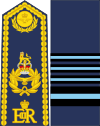 |
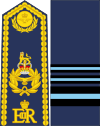 |
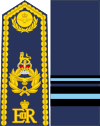 |
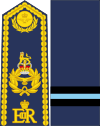 |
 |
 |
 |
 |
 |
 |
 |
|
| Rank Title: | Marshal of the Royal Air Force | Air chief marshal | Air marshal | Air vice-marshal | Air commodore | Group captain | Wing commander | Squadron leader | Flight lieutenant | Flying officer | Pilot officer/ acting pilot officer | Officer cadet |
| Abbreviation: | MRAF | Air Chf Mshl | Air Mshl | AVM | Air Cdre | Gp Capt | Wg Cdr | Sqn Ldr | Flt Lt | Fg Off | Plt Off | Off Cdt |
| Royal Air Force other rank insignia | ||||||||||||
|---|---|---|---|---|---|---|---|---|---|---|---|---|
| NATO rank code | OR-9 | OR-7 | OR-6 | OR-5 | OR-4 | OR-3 | OR-2 | OR-1 | ||||
 |
 |
 |
 |
 |
 |
 |
 |
 |
 |
No insignia
|
||
| Rank Title: | Warrant Officer | Flight Sergeant | Chief Technician | Sergeant | Corporal | Lance Corporal RAF Regiment |
Senior Aircraftman (Technician) | Senior Aircraftman | Leading Aircraftman | Aircraftman | ||
| Abbreviation: | WO | FS | Chf Tech | Sgt | Cpl | L/Cpl | SAC Tech | SAC | LAC | AC | ||
 |
 |
 |
No equivalent
|
|||||||||
| Rank Title: | RAF Master Aircrew | RAF Flight Sergeant Aircrew | RAF Sergeant Aircrew | |||||||||
RAF Aircraft
Air Combat Aircraft
Typhoon Fighter Jets
The Eurofighter Typhoon FGR4 is the RAF's main fighter jet. It can defend against other aircraft and attack ground targets. It took over these roles after the Panavia Tornado F3 retired in 2011. The Typhoon FGR4 also took over ground attack duties from the Panavia Tornado GR4 in 2019. Typhoons defend UK and NATO airspace. They are often sent to support NATO missions in the Baltic and Black Sea.
The RAF has seven main Typhoon squadrons. There is also a training unit (OCU) and an evaluation unit (OEU). These are based at RAF Coningsby and RAF Lossiemouth. Four Typhoons are also based at RAF Mount Pleasant in the Falkland Islands. They provide air defence there. In March 2025, most older Tranche 1 Typhoons were retired. Four remain with No. 1435 Flight until 2027.
The Typhoon first saw combat in 2011 during Operation Ellamy. It has been supporting Operation Shader since December 2015. Typhoons also supported Operation Poseidon Archer from January 2024. The Typhoon got its first air-to-air kill in December 2021. It shot down a small drone in Syria.
Lightning Fighter Jets
The Lockheed Martin F-35 Lightning is a stealthy, single-seat, all-weather combat aircraft. It can perform air superiority and strike missions. It also provides electronic warfare and intelligence, surveillance, and reconnaissance capabilities. The F-35B can take off and land vertically. It is used by both the RAF and the Fleet Air Arm. They often fly from the Royal Navy's aircraft carriers. The F-35A is also being ordered for NATO's nuclear mission. The UK plans to increase its F-35 fleet beyond the current 48. In June 2025, the UK ordered 12 F-35As and 17 F-35Bs. This brings the total ordered to 75 jets. By May 2025, 39 F-35Bs had been delivered.
No. 17 Test and Evaluation Squadron was the first RAF squadron to fly the F-35B in 2014. No. 617 (The Dambusters) Squadron became the first operational RAF Lightning squadron in April 2018. The first F-35Bs arrived at RAF Marham in June 2018. The Lightning was ready for combat in January 2019. No. 207 Squadron became the training unit for F-35B pilots in August 2019. 809 Naval Air Squadron (FAA) became the second front-line F-35B squadron in December 2023. It has both Royal Navy and RAF personnel.
At the 2025 NATO Summit, it was announced the RAF would get at least twelve nuclear-capable F-35As. This brings back a nuclear role for the RAF since 1998. The F-35As will be based at RAF Marham. They will help form a third front-line F-35 squadron.
ISTAR Aircraft
ISTAR stands for Intelligence, Surveillance, Target Acquisition, and Reconnaissance. Six Hawker Beechcraft Shadow R1s are used by No. 14 Squadron at RAF Waddington. These planes are specially changed for ISTAR. The Shadow fleet was given a retirement date of 2030.
Ten General Atomics MQ-9A Reaper drones are used by No. XIII Squadron at RAF Waddington.
Three Boeing RC-135W Rivet Joints (called Airseeker in the RAF) replaced the Hawker Siddeley Nimrod R1 fleet. They are used for signals intelligence. No. 51 Squadron flies them. These aircraft entered service between 2014 and 2017. The Rivet Joint first flew missions in August 2014 over Iraq and Syria. The RC-135W is expected to retire in 2035.
The General Atomics Protector RG1 is being introduced into RAF service. It is expected to start flying operations in 2025. The UK ordered 16 Protectors. The first Protector RG1 arrived at RAF Waddington in September 2023. No. 31 Squadron became the first Protector squadron in October 2023.
No. 54 Squadron and No. 56 Squadron are the training and evaluation units for the ISTAR fleet.
Maritime Patrol Aircraft
Nine Boeing Poseidon MRA1 aircraft were ordered in November 2015. They are used for surveillance, anti-submarine, and anti-ship warfare. This filled a gap after the BAE Systems Nimrod MRA4 program was cancelled in 2010. No. 120 Squadron and No. 201 Squadron operate the Poseidon. They are based at RAF Lossiemouth. No. 42 (Torpedo Bomber) Squadron is the training unit for the Poseidon.
The first Poseidon MRA1 arrived in the UK in February 2020. It filled a decade-long gap in maritime capability. The Poseidon was ready for combat in April 2020. It flew its first mission in August 2020, tracking a Russian warship. The ninth and final Poseidon arrived at RAF Lossiemouth in January 2022.
Air Mobility Aircraft
No. 99 Squadron operates eight Boeing C-17A Globemaster III aircraft. These are used for heavy strategic airlift from RAF Brize Norton. The RAF first leased four C-17s in 2000 and later bought them. They then bought four more, bringing the total to eight.
The Airbus Atlas C1 (A400M) replaced the RAF's C-130 Hercules fleet. The C-130 Hercules had been in service since 1967. The Atlas fleet is based at RAF Brize Norton. It is operated by No. 30 Squadron and No. LXX Squadron. The first Atlas C1 was delivered in November 2014. The final aircraft of the initial order of 22 was delivered in May 2023. The C-130J Hercules retired from RAF service in June 2023.
No. XXIV Squadron trains pilots for the Globemaster and Atlas. No. 206 Squadron is the evaluation unit.
Air transport is also done by the Airbus Voyager KC2/3. No. 10 Squadron and No. 101 Squadron fly these. The first Voyager arrived in the UK in April 2011. It entered service in April 2012. The Voyager can refuel other aircraft in the air. By May 2013, the Voyager fleet had carried over 50,000 passengers. There are 14 Voyagers in the fleet.
Two Dassault Falcon 900XLs were bought in early 2022. They replaced the RAF's BAe 146s for VIP transport. These aircraft are called Envoy IV CC1 in British service. They are based at RAF Northolt. They are flown by a mix of civilian and No. 32 (The Royal) Squadron crew.
Helicopters
RAF helicopters help the British Army move troops and equipment. They also support RAF ground units and the Royal Marines. Support helicopters are part of the tri-service Joint Aviation Command (JAC). No. 22 Squadron at RAF Benson is the evaluation unit for JAC.
The large Boeing Chinook is the RAF's heavy-lift helicopter. It was first ordered in 1978. Chinooks are operated by No. 7 Squadron, No. 18 (B) Squadron, and No. 27 Squadron at RAF Odiham. No. 28 (AC) Squadron trains Chinook pilots at RAF Benson. Since 1980, Chinooks have been in many operations. These include the Falklands War (1982) and operations in Afghanistan and Iraq. The 60 Chinooks are expected to be in service until the 2040s.
Training Aircraft
The UK's military flying training is run by a private company. This is called the UK Military Flying Training System (UKMFTS). New aircraft were bought to better train aircrew. They help bridge the gap between older planes and modern front-line aircraft. UKMFTS also uses a lot of synthetic training.
Initial Training
The Grob Tutor T1 is used by fifteen University Air Squadrons. These give university students RAF training. This includes first solo flights, navigation, and aerobatics. These units also provide air experience flights for cadets. The Tutor is also flown by No. 16 Squadron and No. 115 Squadron at RAF Wittering.
Volunteer Gliding Squadrons give cadets air experience flights using the Grob Viking T1 glider.
Elementary Training
The Grob Prefect T1 became the RAF's elementary trainer in 2016. The 23 Prefects are based at RAF Cranwell and RAF Barkston Heath. After elementary training, aircrew choose to train for fast jets, multi-engine planes, or helicopters.
Basic Fast Jet Training
Basic fast jet training uses the Beechcraft Texan T1. It replaced the Short Tucano T1 in 2019. The Texan is a two-seat turboprop aircraft. It has a digital cockpit. No. 72 (F) Squadron at RAF Valley flies it. They train RAF and Royal Navy fighter pilots. The first Texans arrived in February 2018. Four more were delivered in November 2020.
Advanced Fast Jet Training
The BAE Hawk T2 is flown by No. IV Squadron and No. XXV (F) Squadron at RAF Valley. Pilots learn tactical and weapons training. After advanced training, aircrew go to an Operational Conversion Unit (OCU). There, they learn to fly the Typhoon FGR4 or F-35B Lightning. The OCUs use real aircraft, simulators, and ground training. The Typhoon also has a two-seater training version called the Typhoon T3.
A joint RAF-Qatari Air Force Hawk squadron was formed in September 2021 at RAF Leeming. It became 11 Squadron QEAF in November 2021.
Multi-Engine Training
Multi-Engine aircrew and weapon systems students train on the Embraer Phenom T1. No. 45 Squadron at RAF Cranwell operates it.
Rotary Training
No. 1 Flying Training School (No. 1 FTS) trains helicopter pilots for all UK armed forces. It is based at RAF Shawbury. It flies twenty-nine Airbus Juno HT1 helicopters. No. 1 FTS also includes No. 202 Squadron. This squadron operates the Airbus Jupiter HT1 at RAF Valley.
Future Aircraft Plans
In July 2014, a report suggested the RAF would use both drones and manned aircraft. This included more F-35s and Protector RG1s. It also suggested extending the life of the Typhoon or getting a new manned aircraft. In July 2018, the Defence Secretary announced a £2 billion investment. This was to develop a new British 6th Generation Fighter called Project Tempest. It is planned to replace the Typhoon in 2035.
In March 2019, the UK signed a deal to buy five Boeing E-7 Wedgetails. These will replace the older Boeing E-3D Sentry AEW1 fleet. The E-7s are for Airborne Early Warning and Control (AEW&C). The first E-7 was expected to enter service in 2023. The last aircraft is expected in late 2025 or early 2026. The Wedgetail AEW1 will be based at RAF Lossiemouth. The order was cut to three aircraft in 2021. The Sentry AEW1s were officially retired in September 2021.
In March 2021, a plan was published to get a New Medium Helicopter (NMH). This will replace the Puma HC2 and other helicopters. In May 2022, the competition for up to 44 helicopters began. Four companies qualified: Airbus, Boeing, Leonardo, and Sikorsky/Lockheed Martin. Bidding for the competition opened in February 2024.
RAF Symbols and Uniforms
Like other British armed services, the RAF has its own symbols. These help identify it and build team spirit. Early British aircraft used the Union Flag for identification. But this was confused with German symbols. So, in October 1914, they adopted a system of three circles. It was a red disc, a white ring, and an outer blue ring. This is known as the roundel. The sizes of the rings have changed over time. During the Second World War, a yellow ring was added to the fuselage roundel. Aircraft in the Far East had the red disc removed to avoid confusion with Japanese planes. Today, camouflaged aircraft use low-visibility roundels. Training and transport aircraft still use the traditional red-white-blue roundel.
The RAF's motto is Per Ardua ad Astra. It means "Through Adversity to the Stars" or "Through Struggle to the Stars". A junior officer named J S Yule suggested it.
The badge of the Royal Air Force was first used in August 1918. It shows an eagle flying with its head lowered. It is in front of a circle with the motto and a crown.
Ceremonial Functions and Displays
Red Arrows Display Team
The Red Arrows are the Royal Air Force Aerobatic Team. They are based at RAF Waddington. The team started in 1964. They replaced other unofficial RAF display teams. The Red Arrows badge shows their famous Diamond Nine formation. Their motto is Éclat, which means "brilliance".
They first used seven Folland Gnat trainers. These planes were cheaper to operate than fighter jets. In their first year, they performed at 65 shows. In 1966, the team grew to nine members. This allowed them to create their Diamond Nine formation. In 1979, they switched to the BAE Hawk trainer. The Red Arrows have performed over 4,700 displays in 56 countries.
Royal Air Force Music
Headquarters Royal Air Force Music Services is at RAF Northolt. It supports professional musicians who perform worldwide for the RAF. The Central Band of the Royal Air Force started in 1920. Other bands include the Band of the Royal Air Force College and the Band of the Royal Air Force Regiment.
Trooping the Colour Flypast
The Royal Air Force has provided the flypast for Trooping the Colour since 1913. This is a ceremony for the King's Official Birthday. The Royal Flying Corps first performed a flypast for King George V in 1913.
See also
 In Spanish: Real Fuerza Aérea (Reino Unido) para niños
In Spanish: Real Fuerza Aérea (Reino Unido) para niños
- List of all aircraft current and former of the United Kingdom
- List of military aircraft operational during World War II
- List of Royal Air Force stations
- Structure of the Royal Air Force
- Royal Air Force Air Cadets
- Royal Air Force Museum
- RAF News


